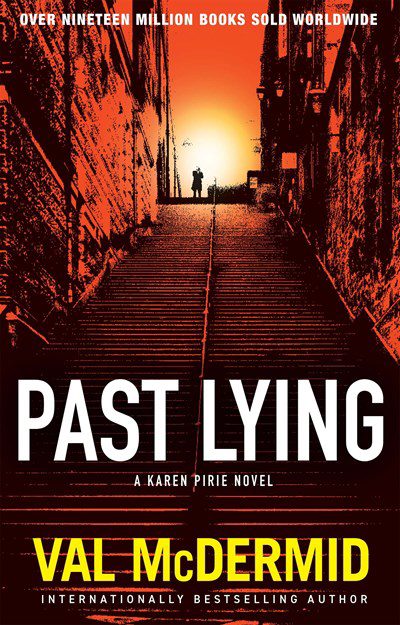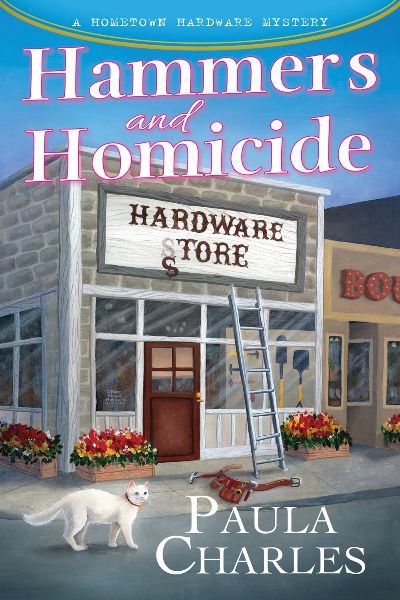This is Estes’s debut novel, but far from her first brush with the TV journalism world portrayed in the book. Like her main character, Jolene Garcia, the author is a reporter in Phoenix, an Emmy winning one at that. Readers will get the feeling that she’s all too familiar with the pressure that’s on Jolene to do it all—investigate, write, present—all while looking fabulous on TV, then rinse and repeat on social media. Jolene is tired of the fluffy stories that the station runs to please the manager’s wife, and when a death occurs at a local radio station, she’s all over it. The deceased might be Alex Jones-alike Larry Lemmon, a talk-show host who divides his time between hating facts and hating immigrants more, a story that’s bound to draw viewers in droves. Dare she hope? And better again, maybe he was murdered. Her TV-news sensation dreams are fulfilled, but many questions remain. Assisting Jolene in getting the scoop on those is a reluctantly helpful police officer whose portrayal of departmental politics and ethics add narrative tension. But best is Jolene’s relentlessness and endurance of whatever it takes to get the story. Estes says that “J.A. Jance’s Ali Reynolds series planted the seed for my writing while Hank Phillippi Ryan’s Jane Ryland series helped it grow,” so fans of those series are a natural fit for this gritty thriller.
Women Sleuths
This new title from Delia Pitts—author of the Ross Agency series—offers everything that fans of detective fiction are looking for. Vandy Myrick, a former cop—she joined the force to impress her cop dad—is now a detective in Queenstown, New Jersey, her hometown, where she sets up a firm with BFF and trial lawyer Elissa. They’re two Black women in a town where racism, “casual like flip flops down the Jersey shore,” is always bubbling right under the surface. Vandy’s work is mainly divorce cases, and when she gets a call from the Mayor’s nephew—Queenstown royalty—asking her to track his wife, she just assumes that one more “Q-Town” marriage has hit the rocks. Except this gig quickly spins out of control when Vandy walks in on a double homicide, one that the powers that be are all too eager to shut down. Pitts has written a strong narrative that ricochets from Vandy’s tragic past to her gutsy present, keeping readers totally engaged to the very last page…and eager for more. Fans of Robyn Gigl’s thrillers will enjoy visiting New Jersey with Vandy.
Well-known for her excellent historical crime fiction—including the Jane Prescott series and, more recently, The Lindbergh Nanny—Fredericks surpasses even those efforts with this dazzling, magical foray into the life of Edith Wharton. It’s 1911, we are in New York City, and Wharton, nearly 50, is down in the dumps. Yes, she’s the witty, acerbic, and a brilliant conversationalist we imagine her to be. But it’s been six years since the publication of her last bestseller. Husband Teddy is mentally ill. Buddy Henry James is aging quickly. Her affair with Morton Fullerton would seem to be over. And all she really wants is to get back to Paris. In short, things aren’t so gilded. When David Graham Phillips, a handsome young novelist, is shot and killed in front of the Princeton Club, it piques Wharton’s interest. She had just met him the day before at tea in the Palm Court, and while her immediate reaction was disdain, as a corpse, Phillips is far more interesting. Who would want to kill a novelist, and why? What is so very brilliant about this novel is that Wharton’s search for the truth—which takes her from the publishing industry (hilarious) to New York society (terrifying)—is skillfully enmeshed with the challenges she faces as a woman, a writer, and a wife. In a particularly poignant scene, Wharton is walking home and realizes she is being followed. She finally turns to confront the perpetrator, only to discover it’s her feeble, slipper-clad husband, following her for fear she’ll abandon him. Sure to be one of the best books of the year, and a perfect choice for book groups that appreciate a rich context.
Real life collides with reality television in a mega-rich section of Los Angeles in Goldberg’s latest thriller. Detective Eva Ronin investigates the discovery of bones found in a park outside a private and secure area called Hidden Hills. That cold case soon requires focusing on a current investigation when a reality star is murdered inside her home while her family sleeps nearby. Hooded thieves broke in and ran when the family awoke to the gunshots. The expected security of the community appears nonexistent. Eva knows about the world of Hollywood since her police role has become a TV series, so she’s used to what is factual being played up for entertainment value. But this case seems to defy logic as more deaths occur, and reality means nobody is safe. Goldberg has created a terrific character in Eva Ronin, and he knows how to write a fast-paced thriller mixed with humor and inside jokes with no fluff. Like Michael Connelly, Goldberg also utilizes the Los Angeles landscape effectively.
Lennon, who has always played with a range of genres in his literary fiction (Broken River, Familiar, Mailman) now dips his pen into more commercial waters with the same inventive, adventurous flair. His new thriller, first in a series, revolves around twins (fraternal, not identical) Jane and Lila Pool. Thirty-five-year-old Jane leads a quiet suburban life in upstate New York, working in a dead-end administrative job at the local college, checking on her absent-minded professor father, and trying to parent adolescent Chloe despite the obnoxious interference of her disapproving mother-in-law. But her comfortable, if boring and unsatisfying, existence is turned upside down when she receives an encrypted email in the guise of spam from her long-estranged sibling. Lila has found their mother, who abandoned the girls 20 years ago, and she wants Jane to come with her to track and confront the wayward Anabel, who may or may not be a CIA agent-turned-drug-queen-pin. As the sisters embark on a whirlwind journey that eventually takes them down to Central America, alternating chapters recount the twins’ lonely, isolated childhood and teenage years as they spy on their distant and remote mother, savoring the few moments of kindness she shows them (“the marvelous, elusive feeling of their mother’s attention”), until Anabel’s final disappearance and an unexpected act of violence propel the girls on a traumatic road trip of escalating bad decisions. Along the way, readers discover who the true hard girl is. Mixing elements of a chase novel with an espionage thriller, this is also a touching story of sisterhood and motherhood in all their complications. Despite a muddled climax, Lennon’s well-written mashup of Where’d You Go, Bernadette and Thelma and Louise, but with a happier ending, will appeal to his fans and attract new readers.
Very British, very country, and a whole lot of fun. Back in 1965, when she was 17, Frances was told by a fortune teller that her future “contains dry bones. Your slow demise begins when you hold the queen in the palm of one hand. Beware the bird…But daughters are the key to justice.” While most teens would shrug it off, Frances became obsessed with the prediction, and devoted much of her life to warding off the prophecy. Jump to today—the story flips back and forth—and meet 25-year-old Annie, an aspiring mystery writer and Frances’s great niece. She’s been summoned to the village of Castle Knoll for a meeting with Great Aunt Frances and a discussion about “the responsibilities that will come with being sole benefactor of her estate and assets.” So off Annie heads to Castle Knoll, meets up with a motley crew of relatives, and quickly manages to arm herself with Great Aunt Frances’s extensive diaries that she discovers in the library. This novel is marvelously well-balanced, humorous, and lighthearted while at the same time dark and macabre, with two great characters—Frances and Annie—who share the narrative from opposite ends. Fans of Anthony Horowitz and Richard Osman will find much to enjoy here
Krystle, Meredith, Justine, and Camille are thrown together when their law-firm owning husbands, and in the case of Meredith, her girlfriend, are killed in a plane crash. The wives already knew and hated one another; the lone female partner in the firm was in the closet (it’s 1985), but is now firmly out, and Meredith joins in the animosity and puzzlement that’s freely flowing. Why were the partners on a plane back to Providence, Rhode Island from New York City, when they were supposed to be working in Providence that day? The reasons slowly become clear as the women are targeted by the town’s mafia for money that the deceased owed. Just when that danger wraps up, a twist hits the widows and readers as another…and another…perilous situation bears down on them. This book began life as an Audible original and its backbiting humor mixed with love and loathing makes it easy to see why it was such a hit and was brought to print. The authors’ note (there’s also a reading-group guide) explains that ‘90s humor-laden novels such as Married to the Mob and The First Wives Club provided inspiration; grab Young Rich Widows for some nostalgia, but it’s also just a fun romp for any thriller lover.
Though there’s a year between them, sisters Crissy and Betsy Dowling are so alike they could be twins. And they don’t only resemble each other, they also look very like one Diana Spencer, the late, lamented Princess of Wales. The resemblance is so strong that Crissy performs as Di in a long-running Las Vegas residency. The casino that hosts the emotional cabaret, the Buckingham Palace, or BP, has seen better days, as has Crissy’s relationship with her lookalike sister. Crissy claims that Betsy killed their mother, the circumstances around that a mystery for most of the book. But that doesn’t stop Betsy from re-entering her sister’s life by leaving her social worker job for her new boyfriend’s cryptocurrency firm that’s setting up shop in Vegas. When the owner of the BP is found dead, and Crissy doesn’t believe the police’s finding that it’s a suicide, it starts a chain of subterfuge and violence that makes the sort-of-royals wish that what happens in Vegas didn’t involve them. Bohjalian has intriguingly veered into a much more noir path than his usual, with the darkness complimenting his typical tight plotting and absorbing family drama. This is one for fans of campy fare mixed with family shenanigans and of Elle Cosimano’s Finlay Donovan.
It’s April 2020, the third week of a pandemic lockdown in an eerily quiet and empty Edinburgh. Detective Chief Inspector Karen Pirie of Police Scotland’s Historic Cases Unit has hunkered down with Detective Sergeant Daisy Mortimer in a “quarantine bubble” in her boyfriend Hamish’s spacious New Town apartment while he isolates up in the Highlands. There are no active cold cases to occupy the two officers, and Karen is languishing while longing for something meaningful to investigate. She fights her restlessness with her daily one-hour walks, the maximum allowed under tight restrictions. But when DC Jason Murray receives a call from a contact at the National Library about an unfinished manuscript in the archives of a recently deceased crime novelist, the team may have stumbled upon a connection to the cold case of a young woman who disappeared a year earlier. But how do they investigate a crime while trying to stay within COVID protocols? A determined Karen finds herself “making mincemeat” of the regulations, but as she tells a colleague, “I have to be out on the streets doing what I do. Because I want the world to still be a decent place when we come out on the other side.” In her seventh atmospheric series thriller, McDermid skillfully combines a twisty plot of murder and vengeance with the personal dramas of her detectives, set against the dramatic backdrop of a global pandemic. By the novel’s end, no one has been left unscathed by this traumatic time. In her acknowledgments, McDermid notes that she penned this novel only in 2023, needing the distance of time to write about those frightening early days. I suspect her book is the first of many crime novels that will explore the impact of COVID on the human psyche.
Dawna Carpenter runs a hardware store in downtown Pine Bluff, Oregon. She struggles to keep it going, especially after the death of her beloved husband, Bob. The building shares space with a boutique, and the woman who runs Lipstick and Lace is a real piece of work. A real-estate developer in town has bold plans to open a luxurious hotel, but when he’s found dead in the hardware store’s bathroom, Dawna’s life gets turned upside down even more than she thought possible. The quirky cast of characters, the slowly building mystery, and the light-hearted tone make Hammers and Homicide a terrific debut. Charles also does an outstanding job of addressing how people deal with the grief of losing a loved one, without being overly depressing. Readers will be fixing to read more mysteries of this series and Paula Charles.










